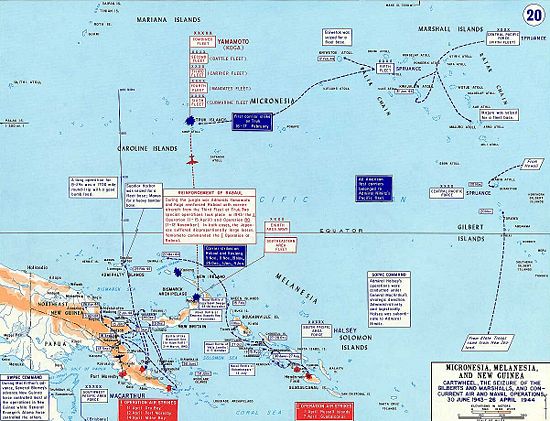Operation CARTWHEEL: Difference between revisions
imported>David E. Volk m (subpages and wikilinks) |
imported>Hayford Peirce m (Rabaul, battle of moved to Battle of Rabaul over redirect: as per request of the Editor-in-Chief regarding the naming of articles about battles)) |
(No difference)
| |
Revision as of 22:20, 22 June 2008
The Battle of Rabaul was a successful air campaign by the U.S. against a Japanese island stronghold in the Pacific in World War II.
In August 1943 the U.S. decided to drop earlier plans to capture the main Japanese forward base of Rabaul, on New Britain, just east of New Guinea, and instead to neutralize and bypass it, leaving its ultimate reduction to air attacks. By fall, indeed, American and Australian advances in New Guinea to the west and in the Solomons to the south had all but isolated Rabaul. Beginning in October, 1943, American and Australian air power, both land- and sea-based, struck repeatedly with increasing intensity at the enemy base, concentrating on eliminating Japanese air strength there. The main AAF (U.S. Air Force) weapon was bombers based in Townsville, Australia,
On 12 October 1943, in the first of a series of raids in support of the pending Bougainville landing, Allied Air Forces in the SWPA theatre mounted the largest strike of the war against Rabaul. AAF General George Kenney later stated that every SWPA plane "that was in commission, and that could fly that far, was on the raid", including 87 B-24s, 114 B-25s, 12 RAAF Beaufighters, 125 P-38s, and 11 weather and reconnaissance planes. Operational accidents and mechanical failures on the long haul from takeoff to target forced 50 of the fighters and bombers to turn back, but the successive attacking waves had strength to spare to overwhelm the 32 Zekes that rose to intercept.
Within a month Rabaul was no longer an offensive threat. By the end of 1943 the line of Allied air bases had advanced close enough to permit the initiation of a sustained air offensive aimed at knocking out the Japanese base completely. This offensive, combined with continuing Allied advances in the central and southwest Pacific, soon rendered Rabaul useless to the enemy as a strategic base.
Under almost daily attack, the Japanese in Rabaul began evacuating aircraft and shipping. By March 1944, when the great Allied air offensive came to an end, roughly 20,000 tons of bombs had been dropped. The nearly 100,000 Japanese troops still defending Rabaul were isolated and impotent, no longer factors in the war. Japan sent in supplies by submarine, but Japanese died of malnutrition and starvation until they surrendered in August, 1945.
Bibliography
- Bergerud, Eric M. Fire in the Sky: The Air War in the South Pacific (2000) [online edition
- Craven, Wesley, and James Cate, eds. The Army Air Forces in World War II. (1958). Official history Vol. 4, The Pacific: Guadalcanal to Saipan, August 1942 to July 1944. 1950 online edition
- Miller, Jr., John. Cartwheel: The Reduction of Rabaul, United States Army in World War II. (1959)
- Sakaida, H. The Siege of Rabaul (1996) 96pp; Japanese perspective; heavily illustrated excerpt and text search
- Shaw, Henry et al. History of U.S. Marine Corps Operations in World War II. Vol. II: Isolation of Rabaul; (1968) online edition
Primary sources
- Boyington, Pappy. Baa Baa Black Sheep (1958)
- McClurg, Robert W., and Leon Marketos. On Boyington's Wing: The Wartime Journals of Black Sheep Squadron Fighter Ace Lt. Col. Robert W. McClurg (2003)
